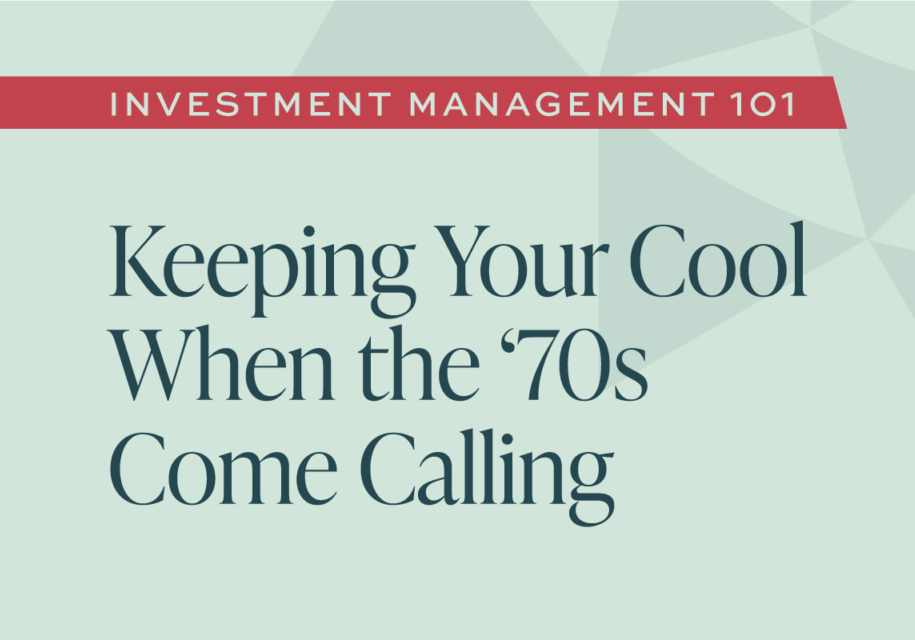Investment Management 101: Keeping Your Cool When the ‘70s Come Calling
By Shannon Gentry Lanier | September 28, 2022


Vintage 1970s – Sears and Winnie the Pooh
“Do You Remember / Never a Cloudy Day / Yow.”1
Raise a virtual hand if you remember long lines at the gas station and 18% mortgage rates. Turn up the heat in the house? Put on another layer! Milk prices spiking 30%? Use water for your hot chocolate! No ham – it’s a bologna sandwich for lunch today. Remember to turn off the lights when you leave the room.
Raise your other virtual hand if you have more fond memories of the ‘70s. Disco, anyone? Maybe you had a leisure suit? A Big Wheel bike with an awesome handbrake? We know you watched Evel Knievel. And major bonus points if your neighborhood celebrated the Bicentennial in 1976 by turning fire hydrants into small patriots.
Ladies don’t usually discuss their age, but we’re not afraid to admit it – we remember all of the above. Been there, done that. And our childhood experiences have proven useful in the current investing environment.
How do you keep your cool when the ‘70s come calling? You let cooler heads prevail. Proper investment management requires controlling emotional impulses, maintaining a healthy perspective and exercising patience.
Yow, indeed. Investing over the long-term means weathering cloudy days and understanding that emotional impulses go both ways. “Bull markets are born on pessimism, grow on skepticism, mature on optimism and die on euphoria.”2 We strive to take emotion out of the investment equation. Investors take note: real or perceived losses hurt worse than gains feel good.
Next, it’s important to maintain a healthy perspective. The Standard & Poor’s 500 is a handy bellwether for the broader equities markets.3 The S&P 500 is down over 20% year to date and reached a low (-23.3%) in June.4 However, the index has finished with a positive annual return 51 times out of the last 64 years, for a winning percentage of almost 80%.5 Pretty good odds.6 We agree with the Oracle of Omaha – “Despite some severe interruptions, our country’s economic progress has been breathtaking. Our unwavering conclusion: Never bet against America.”7
Last, it pays to be patient. Staying fully invested in the S&P 500 between January 1, 2002 and December 31, 2021 would have resulted in average annual returns of 9.52%.8 Selling out of the market and missing the ten best days would have reduced the returns by almost half, to 5.33%.9 Missing the twenty best days would have reduced the returns by another half, to 2.63%.10 And importantly, seven of the best ten days occurred within two weeks of the ten worst days.11 Short version: it pays to be patient.
“While chasin’ the clouds away.”12 While we remember long lines at the gas station and wearing jackets inside during the winter, we also know the current clouds will eventually be chased away. Volatility like we have experienced this year is the price we pay for returns. The malaise of the ‘70s gave way to the great bull markets of the ‘80s (August 1982 to October 1987) and ‘90s (October 1990 to early 2000). We believe that investors who learn from the ‘70s and keep their cool should be better positioned to weather the current downturn and take advantage of opportunities on the way to the next great bull market.
Footnotes
- Earth, Wind & Fire – September (1978).
- Sir John Templeton.
- Also known as the S&P 500, a stock market index tracking the stock performance of 500 large publicly-traded companies in the United States. It is a useful measure of performance for the U.S. equities markets.
- As of the date of this writing.
- DataTrek Morning Briefing, September 13, 2022. More specifically, 79.69%.
- Disclaimer: This is not an endorsement of index investing – a topic for another day.
- Warren Buffett, 2021 annual letter to shareholders of Berkshire Hathaway, Inc.
- ClearBridge Investments.
- Id.
- Id.
- Id.
- Earth, Wind & Fire – September (1978).